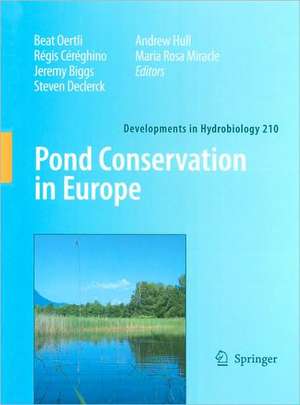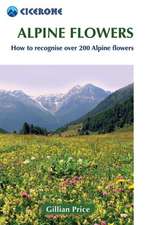Pond Conservation in Europe: Developments in Hydrobiology, cartea 210
Editat de Beat Oertli, Régis Céréghino, Jeremy Biggs, Steven Declerck, Andrew P. Hull, Maria Rosa Miracleen Limba Engleză Hardback – 6 apr 2010
| Toate formatele și edițiile | Preț | Express |
|---|---|---|
| Paperback (1) | 806.73 lei 38-44 zile | |
| SPRINGER NETHERLANDS – 28 mai 2012 | 806.73 lei 38-44 zile | |
| Hardback (1) | 822.76 lei 38-44 zile | |
| SPRINGER NETHERLANDS – 6 apr 2010 | 822.76 lei 38-44 zile |
Din seria Developments in Hydrobiology
- 18%
 Preț: 1229.10 lei
Preț: 1229.10 lei - 18%
 Preț: 959.98 lei
Preț: 959.98 lei - 18%
 Preț: 963.91 lei
Preț: 963.91 lei -
 Preț: 788.40 lei
Preț: 788.40 lei - 15%
 Preț: 648.24 lei
Preț: 648.24 lei - 15%
 Preț: 637.89 lei
Preț: 637.89 lei -
 Preț: 378.23 lei
Preț: 378.23 lei - 15%
 Preț: 644.95 lei
Preț: 644.95 lei - 18%
 Preț: 952.09 lei
Preț: 952.09 lei - 20%
 Preț: 558.87 lei
Preț: 558.87 lei - 18%
 Preț: 1833.65 lei
Preț: 1833.65 lei -
 Preț: 393.59 lei
Preț: 393.59 lei -
 Preț: 406.54 lei
Preț: 406.54 lei - 18%
 Preț: 1226.73 lei
Preț: 1226.73 lei - 18%
 Preț: 956.99 lei
Preț: 956.99 lei -
 Preț: 388.87 lei
Preț: 388.87 lei - 24%
 Preț: 1060.51 lei
Preț: 1060.51 lei - 18%
 Preț: 1229.28 lei
Preț: 1229.28 lei - 20%
 Preț: 569.30 lei
Preț: 569.30 lei -
 Preț: 368.79 lei
Preț: 368.79 lei - 24%
 Preț: 817.46 lei
Preț: 817.46 lei - 18%
 Preț: 958.25 lei
Preț: 958.25 lei - 18%
 Preț: 953.03 lei
Preț: 953.03 lei -
 Preț: 384.75 lei
Preț: 384.75 lei - 24%
 Preț: 1582.91 lei
Preț: 1582.91 lei - 24%
 Preț: 1051.68 lei
Preț: 1051.68 lei - 18%
 Preț: 943.57 lei
Preț: 943.57 lei - 18%
 Preț: 1235.76 lei
Preț: 1235.76 lei - 24%
 Preț: 800.02 lei
Preț: 800.02 lei - 24%
 Preț: 803.55 lei
Preț: 803.55 lei - 18%
 Preț: 948.29 lei
Preț: 948.29 lei
Preț: 822.76 lei
Preț vechi: 1082.57 lei
-24% Nou
Puncte Express: 1234
Preț estimativ în valută:
157.51€ • 162.07$ • 132.77£
157.51€ • 162.07$ • 132.77£
Carte tipărită la comandă
Livrare economică 25 februarie-03 martie
Preluare comenzi: 021 569.72.76
Specificații
ISBN-13: 9789048190874
ISBN-10: 9048190878
Pagini: 385
Ilustrații: VIII, 386 p.
Dimensiuni: 193 x 260 x 30 mm
Ediția:2010
Editura: SPRINGER NETHERLANDS
Colecția Springer
Seria Developments in Hydrobiology
Locul publicării:Dordrecht, Netherlands
ISBN-10: 9048190878
Pagini: 385
Ilustrații: VIII, 386 p.
Dimensiuni: 193 x 260 x 30 mm
Ediția:2010
Editura: SPRINGER NETHERLANDS
Colecția Springer
Seria Developments in Hydrobiology
Locul publicării:Dordrecht, Netherlands
Public țintă
ResearchCuprins
The ecology of European ponds: defining the characteristics of a neglected freshwater habitat.- A comparison of the catchment sizes of rivers, streams, ponds, ditches and lakes: implications for protecting aquatic biodiversity in an agricultural landscape.- A comparative analysis of cladoceran communities from different water body types: patterns in community composition and diversity.- Macroinvertebrate assemblages in 25 high alpine ponds of the Swiss National Park (Cirque of Macun) and relation to environmental variables.- Biodiversity and distribution patterns of freshwater invertebrates in farm ponds of a south-western French agricultural landscape.- Patterns of composition and species richness of crustaceans and aquatic insects along environmental gradients in Mediterranean water bodies.- Relation between macroinvertebrate life strategies and habitat traits in Mediterranean salt marsh ponds (Empordà wetlands, NE Iberian Peninsula).- Macrophyte diversity and physico-chemical characteristics of Tyrrhenian coast ponds in central Italy: implications for conservation.- Evaluation of sampling methods for macroinvertebrate biodiversity estimation in heavily vegetated ponds.- Developing a multimetric index of ecological integrity based on macroinvertebrates of mountain ponds in central Italy.- Eutrophication: are mayflies (Ephemeroptera) good bioindicators for ponds?.- How can we make new ponds biodiverse? A case study monitored over 7 years.- Management of an ornamental pond as a conservation site for a threatened native fish species, crucian carp Carassius carassius.- Pond conservation: from science to practice.- Plant communities as a tool in temporary ponds conservation in SW Portugal.- Freshwater diatom and macroinvertebrate diversity of coastal permanent pondsalong a gradient of human impact in a Mediterranean eco-region.- The M-NIP: a macrophyte-based Nutrient Index for Ponds.- Vegetation recolonisation of a Mediterranean temporary pool in Morocco following small-scale experimental disturbance.- Experimental study of the effect of hydrology and mechanical soil disturbance on plant communities in Mediterranean temporary pools in Western Morocco.- Restoring ponds for amphibians: a success story.- High diversity of Ruppia meadows in saline ponds and lakes of the western Mediterranean.- Gravel pits support waterbird diversity in an urban landscape.- Competition in microcosm between a clonal plant species (Bolboschoenus maritimus) and a rare quillwort (Isoetes setacea) from Mediterranean temporary pools of southern France.- Restoration potential of biomanipulation for eutrophic peri-urban ponds: the role of zooplankton size and submerged macrophyte cover.- Spatial and temporal patterns of pioneer macrofauna in recently created ponds: taxonomic and functional approaches.- Comparison of macroinvertebrate community structure and driving environmental factors in natural and wastewater treatment ponds.- Inter- and intra-annual variations of macroinvertebrate assemblages are related to the hydroperiod in Mediterranean temporary ponds.- Ten-year dynamics of vegetation in a Mediterranean temporary pool in western Morocco.- Modelling hydrological characteristics of Mediterranean Temporary Ponds and potential impacts from climate change.- Monitoring the invasion of the aquatic bug Trichocorixa verticalis verticalis (Hemiptera: Corixidae) in the wetlands of Doñana National Park (SW Spain).- Copepods and branchiopods of temporary ponds in the Doñana Natural Area (SW Spain): a four-decade record (1964–2007).
Textul de pe ultima copertă
Ponds are an exceptional freshwater resource around the world and represent thirty percent of the global surface area of standing water. Furthermore, the millions of ponds which exist exhibit a particularly high biodiversity and have a high potential for ecosystem functions and services. Despite these impressive features, ponds face many threats from a variety of human activities and receive little or no protection under European and national legislation. Consequently, there is an urgent need to protect, consolidate and increase the pond resource in Europe. In order to achieve these objectives, the European Pond Conservation Network (EPCN) was launched 2004 in Geneva. Its aim is to promote the awareness, understanding and conservation of these small water bodies in the European landscape. This volume of “Developments in Hydrobiology” presents a selection of 31 papers presented during EPCN conferences held in 2006 in France (Toulouse) and in 2008 in Spain (Valencia). They represent a diverse collection of themes from across the continent and North Africa and present new and original insights into topics as wide ranging as pond biodiversity; human disturbance; landscape ecology; ecological assessment and monitoring; practical management measures; ecological restoration; hydrology and climate change; invasive species and threatened species.
Caracteristici
Features the latest research on pond conservation Covers Pond Biodiversity which is an essential feature of freshwater biodiversity Addresses the significant impact of small water bodies such as ponds










